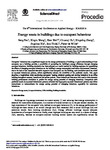Energy Waste in Buildings Due to Occupant Behaviour
| dc.contributor.author | Pan, S | |
| dc.contributor.author | Wang, X | |
| dc.contributor.author | Wei, S | |
| dc.contributor.author | Xu, C | |
| dc.contributor.author | Zhang, X | |
| dc.contributor.author | Xie, J | |
| dc.contributor.author | Tindall, J | |
| dc.contributor.author | de Wilde, Pieter | |
| dc.date.accessioned | 2021-09-20T13:11:30Z | |
| dc.date.available | 2021-09-20T13:11:30Z | |
| dc.date.issued | 2017-05 | |
| dc.identifier.issn | 1876-6102 | |
| dc.identifier.uri | http://hdl.handle.net/10026.1/17877 | |
| dc.description.abstract |
Occupants’ behaviour has a significant impact on the energy performance of buildings. A good understanding of how occupants use a building provides a possibility of promoting the building's energy efficiency through changing occupant behaviour. Building simulation has been adopted as a useful method by building engineers for quantifying the effects of changing occupant behaviour on the building's energy consumption and indoor environment. However, due to the lack of real measured data with respect to how occupants use the building, such simulation work has relied on assumed behavioural patterns, which significantly reduces the reliability of the predicted results. This paper describes a longitudinal study monitoring occupants’ heating, window opening and cooling behaviour in an office building throughout summer, transitional and winter periods. These behavioural data were then used to drive dynamic building performance simulation to predict the energy saving potential of changing behaviour. Comparison with predicted results by assumed behavioural patterns reflected that improperly assumed behavioural patterns may either overestimate or underestimate the energy saving potential of changing behaviour, especially for unextreme behaviours. | |
| dc.format.extent | 2233-2238 | |
| dc.language.iso | en | |
| dc.publisher | Elsevier BV | |
| dc.subject | Energy waste | |
| dc.subject | Occupant behaviour | |
| dc.subject | Office building | |
| dc.subject | Building simulation | |
| dc.title | Energy Waste in Buildings Due to Occupant Behaviour | |
| dc.type | conference | |
| dc.type | Conference Proceeding | |
| plymouth.author-url | https://www.webofscience.com/api/gateway?GWVersion=2&SrcApp=PARTNER_APP&SrcAuth=LinksAMR&KeyUT=WOS:000404967902054&DestLinkType=FullRecord&DestApp=ALL_WOS&UsrCustomerID=11bb513d99f797142bcfeffcc58ea008 | |
| plymouth.volume | 105 | |
| plymouth.publication-status | Published | |
| plymouth.journal | Energy Procedia | |
| dc.identifier.doi | 10.1016/j.egypro.2017.03.636 | |
| plymouth.organisational-group | /Plymouth | |
| plymouth.organisational-group | /Plymouth/Faculty of Arts, Humanities and Business | |
| plymouth.organisational-group | /Plymouth/REF 2021 Researchers by UoA | |
| plymouth.organisational-group | /Plymouth/REF 2021 Researchers by UoA/UoA13 Architecture, Built Environment and Planning | |
| dcterms.dateAccepted | 2017-01-01 | |
| dc.rights.embargodate | 2023-3-1 | |
| dc.rights.embargoperiod | Not known | |
| rioxxterms.versionofrecord | 10.1016/j.egypro.2017.03.636 | |
| rioxxterms.licenseref.uri | http://www.rioxx.net/licenses/all-rights-reserved | |
| rioxxterms.type | Conference Paper/Proceeding/Abstract |


